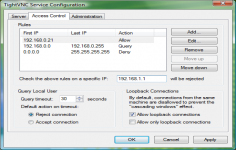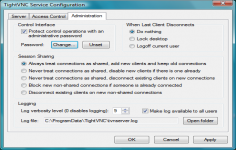 TightVNC 1.3.10
TightVNC 1.3.10
TightVNC - (Open Source)
TightVNC allows to remotely control a computer via Internet making it very easy to take care of a computer maintenance.
TightVNC is a program for remote control and administration via the Internet on a computer no matter what kind of operating system is installed.
The software allows to see in real time all this happens on controlled computer as if user is sitting at its computers. Besides monitoring, TightVNC is also able to optimize bandwidth. TightVNC is a free software compatible with the standard VNC.
This software is also very useful for making a remote computer maintenance.
- Title:
- TightVNC 1.3.10
- File Size:
- 1.4 MB
- Requirements:
- Windows (All Versions)
- Language:
- en-us
- License:
- Open Source
- Date Added:
- 05 Mar 2009
- Publisher:
- TightVNC
- Homepage:
- http://www.tightvnc.com
- MD5 Checksum:
- 88088D2A94BB936049B301119CB0A8A3
* Windows Server: Impersonating currently logged on user while processing file transfer requests. Disabling file transfers if current user is unknown or nobody is logged in.
* Windows Server: Fixed rendering problems when multiple CopyRects were combined with normal updates. That could caused distortions that never updated even with full-screen polling active.
* Windows Server: Added new "-silent" command-line option which modifies the behavior of -install, -reinstall and -remove options and makes them not show informational windows on successful execution. Note that -silent should precede other respective options in the command line.
* Windows Server: LastRect, XCursor and RichCursor pseudo-encodings were not properly enabled if they preceded true encodings in the SetEncodings protocol message.
* Windows Viewer: Fixed integer overflow vulnerabilities reported by Core Security Technologies. A specially modified VNC server could currupt the heap of the connected viewer causing its crash or malfunction.
* Windows Viewer: TightVNC Viewer version 1.3.9 saved only successful connections in the list of recently visited VNC servers. Now we save unsuccessful connections too so that users would not ever have to re-type server names after connection failures. Also, several other enhancements were made to the code which handles the list of recent connections.
* Windows Viewer: Fixed a bug with not loading passwords from saved .vnc files correctly if the first byte of their encrypted representation was zero.
* Windows Viewer: Fixed problems under Windows Vista where Windows taskbar could remain visible above the full-screen window.
* Windows Viewer: Fixed a problem with decoding JPEG rectangles wider than 2048 pixels.
* Windows Viewer: Fixed a bug with not saving log file name correctly on using the Browse button.
* Windows Viewer: Usability improvements in the "New Connection" dialog.
* Windows Packaging: Improved installer and uninstall utility. In this version, self-installing executable will not try to install service in Windows Vista. Improved uninstall program always removes the WinVNC service if it was previously installed.
* Unix Server: Applied fixes for 64-bit Linux issues, a patch from Russel Miranda.
* Unix Server: Made the vncserver script read configuration from files (system-wide /etc/tightvncserver.conf and user-specific $HOME/.vnc/tightvncserver.conf).
* All viewers: Allow configuring JPEG quality level regardless of the preferred encoding set. This makes sense because TightVNC Servers can transmit video data as JPEG even if Tight is not the preferred encoding.
* Java viewer: Fixed a bug that caused NullPointerException when connecting to any VNC server not supporting TightVNC protocol extensions.
* Java viewer: Fixed a bug with ignoreCursorUpdates option in 24-bit color mode caused the viewer to disconnect. Thanks to Damien Mascre for pointing out the issue.
* Java viewer: PORT parameter is not required any more, now it defaults to 5900.
* Java viewer: Do not defer update requests by default, to minimize delays in screen updates.
* Java viewer: Improvements in reporting statistics on disconnect.
* Java viewer: Added debugging parameters (DEBUG_XU, DEBUG_CU) that allow using the viewer as a tool for measuring VNC server performance.
* Other minor improvements and bugfixes.
Related software
4.8/5 from 47 users


